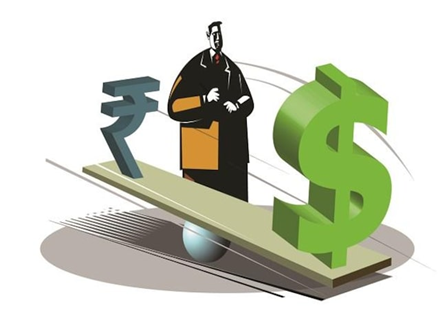

Context
For the first time, the Indian rupee breached the barrier of 77 against the dollar to close at a record low of 77.46, raising fears that India’s inflation situation could worsen.
- Every 5% fall in the rupee adds about 10-15 bps to the inflation.

|
What is a rupee?
|
Background
- Indian currency began with devaluation in 1949 due to devaluation of Pound sterling (UK currency).
- However since India's trade was largely in Pound sterling (just after independence) it did not register much impact like the two major devaluations of the rupee: In 1966 and 1991 in the face of economic crisis.
- India started having the balance of payments problems since 1985, and by the end of 1990, it found itself in serious economic trouble.
- The government was close to default and its foreign exchange reserves had dried up to the point that India could barely finance three weeks’ worth of imports.
- As in 1966, India faced high inflation and large government budget deficits. This led the government to devalue the rupee.
- In the period between 2000 and 2007, the Rupee stopped declining and stabilised ranging between 1 $ = Rs 44– Rs 48.
- In 2016 saw the discontinuation of ?500 and ?1,000 notes due to the 2016 Indian bank note demonetisationand consequently the introduction of new a ?500 note, and a ?2,000 note- a first for the currency.
- At present after pandemic situation is slowed down, the country is again facing the rupee depreciation, hence evident that depreciation of a currency is just not depends upon single factor, but can has many reasons behind its downfall.
Analysis
What is depreciation?
- Currency depreciation is a fall in the value of a currency in a floating exchangerate system.
- Rupee depreciation means that the rupee has become less valuable with respect to the dollar.
- It means that the rupee is now weaker than what it used to be earlier.
- For example: USD 1 used to equal to Rs. 70,now USD 1 is equal to Rs. 77, implying that the rupee has depreciated relative to the dollar i.e. it takes more rupees to purchase a dollar.
|
Depreciation Vs Devaluation
|
What are the reasons for current depreciation of rupee?
- Sell-off of the Equity:
- A sell-off in the global equity marketswhich was triggered by the hike in interest rates by the U.S. Federal Reserve (central bank), the war in Europe and growth concerns in China due to the Covid-19 surge, led to the rupee depreciation.
- Outflow of Dollar:
- The outflow of dollars is a result of high crude pricesand the correction in equity markets is also causing adverse flow of dollars.
- Tightening of Monetary Policy:
- Steps taken by RBI to tighten the monetary policyto counter rising inflation had also led to depreciation.
What are the impacts of depreciation on Indian Economy?
- Rise in Inflation: It poses risk of imported inflation, and may make it difficult for the central bank to maintain interest rates at a record low for longer.
- With higher landed prices of crude oil and other crucial imports, the economy is definitely inching towards cost-push inflation.
- Cost-push inflation (also known as wage-push inflation) occurs when overall prices increase (inflation) due to increases in the cost of wages and raw materials.
- More cost on imports: India meets more than two-thirds of its domestic oil requirements through imports.
- India is also one of the top importers of edible oils. A weaker currency will further escalate imported edible oil prices and lead to a higher food inflation
- Lack of foreign exchange reserves: The current account deficit is bound to widen, depleting foreign exchange reserves and weakening the rupee.
- Companies may not be allowed to fully pass on the burden of high costs to consumers, which, in turn, affect the government dividend earnings, raising questions about budgeted fiscal deficits.
Is Depreciation of Rupee beneficial too in some way?
- Depreciation in rupee is a double-edged sword for the Reserve Bank of India.
- Weaker rupee should theoretically give a boost to India’s exports, but in an environment of uncertainty and weak global demand, a fall in the external value of rupee may not translate into higher exports.
- Indian market flooded with A grade goods: the depreciation of rupee will make exports lesser and high quality Indian goods which were used to export for other countries will now be come to local markets.
- For ex:- fresh fruits, spices, exotic vegetables and other products.
Conclusion
The rupee was never equal to the dollar. At the time of independence, India's currency was pegged to pound sterling, and the exchange rate was a shilling and worked out to Rs 13.33 to the pound. The present situation requires stringent monetary policies for the government and RBI to implement to control the rising prices of basic commodities. Inflation and foreign trade accounts to India’s major source for economy stabilization, and hence this is only targeted if the rupee depreciation will reduce.
|
Practice Question Q1. Recently, the Indian rupee breached the psychological barrier of 77 against the dollar. What are the reasons for the depreciation of rupee? How is it going to affect the Indian economy? Q2. The falling value of rupee says a lot about the fundamentals of Indian economy. Discuss. |


